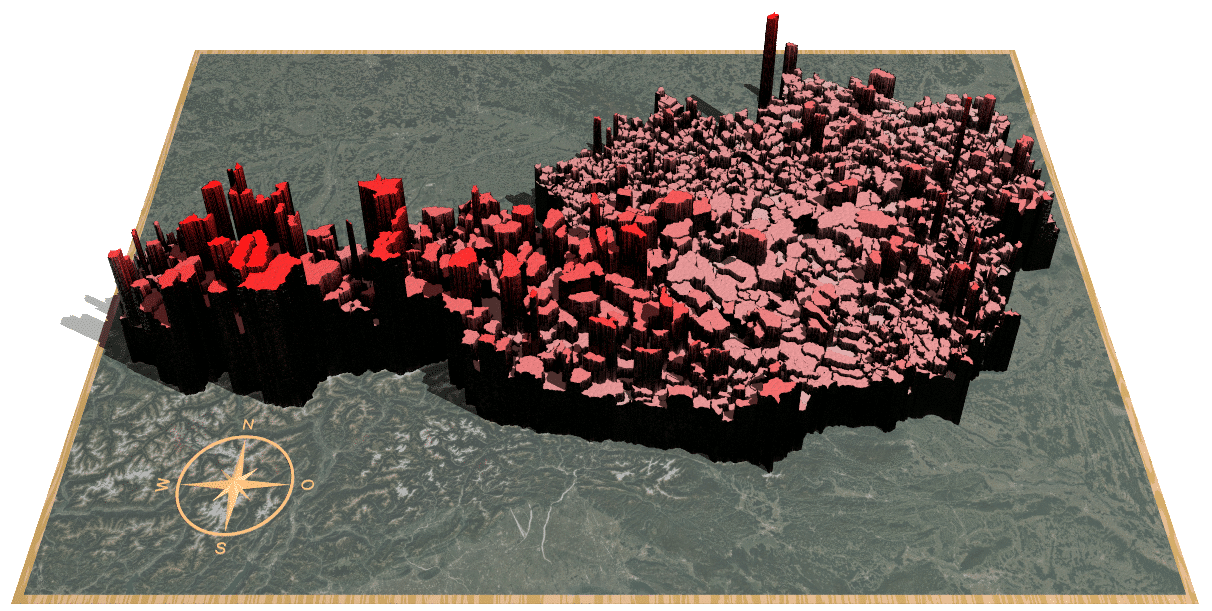An area-wide analysis for all cities and municipalities
This study shows the damage caused by the COVID-19 pandemic for all 2,095 cities and municipalities in Austria. The higher the column, the greater the damage, measured as a percentage of pre-COVID "gross local product" (i.e., gross value added at the municipality/city level).

Interpretation
• An enormous west-east divide is evident: The western provinces experience far greater COVID-related losses than the eastern provinces; Austria is divided in two, so to speak, along a diagonal running between Salzburg and Carinthia;
• The differences in the impact on the municipalities are essentially due to the sectoral structure. Although industry in Tyrol and Vorarlberg also contributes more to regional economic output than the tourism industry, the lockdown, with its value-added losses approaching 100% during the acute phase, has a greater impact.
• Conversely, those parts of Austria that are characterized by technology- and knowledge-intensive value creation record lower losses in percentage terms. This, in turn, shows the importance of industry and academia as an important factor of prosperity.
• The German government's initial response to the COVID 19 pandemic was rapid, large-scale and symmetrical, especially by European standards. For example, it introduced the instrument of short-time work across the board without differentiating between federal states or sectors. However, since the economic damage caused by COVID-19 is asymmetrical in regional and sectoral terms, more differentiated measures should be introduced from now on. The aim of these measures is, on the one hand, to limit the budgetary burden at the federal level and, on the other hand, to achieve the greatest possible reduction in damage. In particular, the federal states are now increasingly called upon, not least in accordance with the principle of subsidiarity.
• Additional demand-stimulating measures are currently not necessary - at least in large parts of Austria - and if they are, they should be highly specific activity-oriented.
• Instead, supply-side measures are needed to support the technological structural change that is already taking place but has been accelerated by COVID-19 and, if necessary, to cushion it socially. These include the abolition of subsidies based on the watering-can principle, greater training in innovation and technology subsidies, including in non-industrial sectors such as tourism, retraining and upgrading measures for unemployed or underemployed workers, and innovative financial instruments, not least to enable competitive company sizes.
Applied methods
In the wake of the COVID-19 pandemic, Economica has prepared weekly macroeconomic forecast updates on behalf of the Federation of Austrian Industries based on the COVID-19 impact of all 75 sectors of the Austrian economy. The April 14 forecast of -7.6% has remained unchanged since then.
Based on the respective sectoral impact, the COVID 19 impact was calculated for all cities and municipalities using the sectoral breakdown of the municipal gross local product by combining the two data sets, i.e. the above graph is based on 157,125 data points. Accordingly, deviations may occur in individual cases if the specific COVID-19 impact of a relevant actor (mostly businesses or public institutions) differs significantly from the industry average impact.
Your contacts for queries

Mag. Günther Grohall
Tel.: +43 660 3200 417
Mail: guenther.grohall@economica.eu

Univ.-Prof. Dr. Christian Helmenstein
Tel.: +43 676 3200 401
Mail: christian.helmenstein@economica.eu

